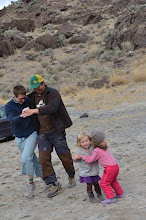The road ends at a fence, but it is a public path that goes through to the back road. Mostly the gate is to keep the grazing animals away from the growing vegetables. The electrical line ends right here. The electric company comes around every once in awhile in company of the police and they arrest anyone who has set up a tenous wire to the last pole. But, if anyone goes into the office to ask about offical lines being extended they are told that there is no plan to extend electric lines. So everyone hooks up to the poles that are there with dangerous fire/electicution hazzard wires and relies on the word of the street being spread to them before the police show up at the door. The white pipe on the right is typical of the place where these children get their daily water. Usually it is a broken pipe, which sticks out from the stagnant water of the trenchs. The water comes out of the pipe usually once a day for a few hours, but sometimes nothing comes out for weeks and then everyone goes searching.

